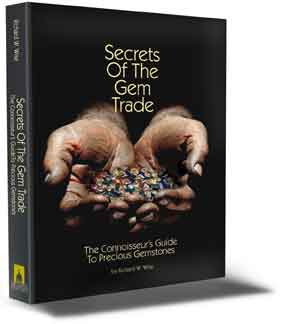Gem Prices in The New Gilded Age
By Richard W. Wise, G.G.
©2007
Gem prices are definitely on the rise. However, these price increases seem to be following general market trends that is, the largest price increasing have been at the very upper end of the market while commercial qualities have remained more or less static. This compares almost exactly to the situation in the U. S. real-estate market.
From Florida’s Miami Beach to The Berkshires of Massachusetts, homes in the under 1 million price range are languishing on the market while homes priced in the one million plus category find ready buyers. In a recent article the New York Times it is reported that condos priced at a median price of 1 million in the Miami area have slipped slightly while those at the 1.5 million level have actually seen a slight increase. In the upscale Berkshire Mountains of Massachusetts the story repeats itself. Prices on single family homes below 1 million are not selling while the market for 1 million plus homes is described as brisk.
Likewise, Prices for fine quality Black opal have doubled in three years and prices for ruby, particularly the very rare fine unheated stones has risen 60%. Due to a diversity of sources, prices for unenhanced fine blue sapphire, the most popular colored gemstone in the U. S. is up a paltry 20%.
Some of this increase is due to the weak dollar which is down 40% against the Australian dollar, 20% against the baht and 22% against the Columbian peso. This has made U. S. real estate relatively cheap for foreign buyers. Since the international gem market operates mainly in dollars the effect has been similar.
As we move toward the low-end, gem prices have hardly moved at all. The bread and butter market is in the doldrums, commercial to good qualities have hardly moved upward at all. In fact, the entire low to mid range jewelry industry is experiencing something of a recession.
I Get Letters:
Seems like I get at least one question like this every week:
Judy from Melbourne writes:
Hello,
Thank you for your site and all your wonderful articles and books.
I wonder if you can help with how to appraise a very unusual stone my partner is thinking of buying. It is a 66ct peridot, loupe clean, square step cut with a deep pavilion, very dark green (but not olive) with almost no yellow, evenly saturated, and bought in Burma from the Burmese owner of a small mine.
The price being asked is around…(removed)…Appraisers here in Melbourne have never seen a similar stone, and say they have no benchmark for it, but it has been suggested that collectors might pay substantially more than the price being asked.
I would very much appreciate any guidance you can give me.
Answer:
Like Antiques Road Show in braille.
Judi,
How does one answer such a question without seeing the stone. I get quite a few similar emails so, if you don’t mind I will post the question and answer on my blog. This reminds me of a call in program occasionally run on our local radio station, WAMC. Two antique dealers are asked to value items described by the callers. They never actually see the item but that fact does not seem to get in their way. Its like Antiques Road Show in braille.
One of a kind stones, big stones are difficult to appraise even when they are in front of you. Is there a peridot worth that price, certainly! Based on a respected price list, the top retail price for Peridot in that size would be $360 per carat. for an extra fine gem. Is your stone worth that much? I really have no idea. The best one I ever saw had an asking price of $5,000 per carat. You say its not olive meaning no gray mask? The depth of color (saturation, tone, crystal and the quality of the cut would be the remaining key factors.
My best advise: Show it to someone who knows. In lieu of that, its anybody’s guess
Whats a buyer to do?
Follow me on gem buying adventures in the pearl farms of Tahiti. Visit the gem fields of Australia and Brazil. 120 carefully selected photographs showing examples of the highest quality gems to<
img style="margin: 0pt 10px 10px 0pt; float: left; cursor: pointer;" src="http://3.bp.blogspot.com/_jPHBjO2OLDs/RjD1BsdOzzI/AAAAAAAAALU/cJrRFFng7C8/s400/Front+cover++3-D+art.jpg" alt="" id="BLOGGER_PHOTO_ID_5057811790999506738" border="0" /> educate the eye, including the Rockefeller Sapphire and many more of the world’s most famous gems. Consider my book: Secrets Of The Gem Trade, The Connoisseur’s Guide To Precious Gemstones.
“Wise is a renowned author… He’s
done a marvelous job of this first book, monumental work, a tour de force…My recommendation: Buy this book”.
Charles Lewton-Brain, Orchid
whether you like to know what the best colour is in Tanzanite, or how to grade a Diamond, you will find it in this book. No other book I read before dealt with this topic is such detail as Richard Wise’s masterpiece.”
A. Van Acker, FGA
Amazon June 2005
“Secrets Of The Gem Trade: The Connoisseurs Guide To Precious Gemstones by Richard W. Wise is an impressive new reference for dedicated dealers and collectors of gems, gemstones, and … pearls. Introducing and descriptively exploring each and every gem covered in the easy-to-use reference, Secrets Of The Gem Trade contains an illustrated summary of each stone inclusive of its history and general information, hue and tone, saturation, which may be noticed as the finest, an understanding of the particular gems rarity, and the caution for synthetics and how to depict them, however depending upon the stone there may be description of clarity, color fading, multi-color effect, etc. Secrets Of The Gem Trade is very highly recommended to anyone interested in gemology as a superbly organized, authoritative, comprehensive, and easy-to-follow reference.”
Midwest Book Review
April 2006
Only $37.95. Read a couple of chapters online: www.secretsofthegemtrade.com.
Buy it on Amazon: www.amazon.com




